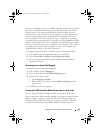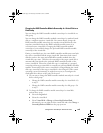
142 Configuration: Disk Groups and Virtual Disks
When you choose this type of configuration, all of the hosts must have the
same operating system and special software (such as clustering software) to
manage virtual disk sharing and accessibility.
More than one storage partition is required if:
• Specific hosts must access specific virtual disks in the storage array.
• Hosts with different operating systems are attached to the same storage
array. In this case, a storage partition is created for each host type.
You can use the Storage Partitioning Wizard to define a single storage
partition. The Storage Partitioning Wizard guides you through the major
steps required to specify which host groups, hosts, virtual disks, and
associated logical unit numbers (LUNs) are to be included in the storage
partition.
Storage partitioning fails when:
• All mappings are defined.
• You create a mapping for a host group that conflicts with an established
mapping for a host in the host group.
• You create a mapping for a host in a host group that conflicts with an
established mapping for the host group.
Storage partitioning is unavailable when:
• No valid host groups or hosts exist in the Topology pane on the
Mappings
tab.
• No host ports are defined for the host being included in the storage
partition.
• All mappings are defined.
NOTE: You can include a secondary virtual disk in a storage partition.
However, any hosts that are mapped to the secondary virtual disk has read-
only access until the virtual disk is promoted to a primary virtual disk, or the
mirror relationship is removed.
book.book Page 142 Thursday, December 9, 2010 3:20 PM


















